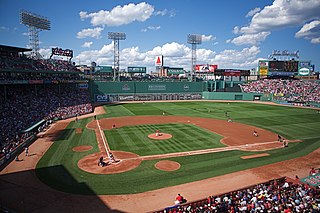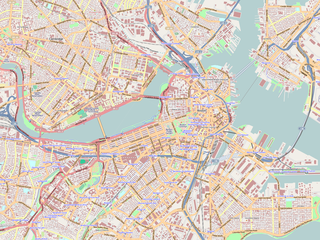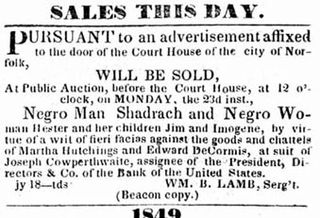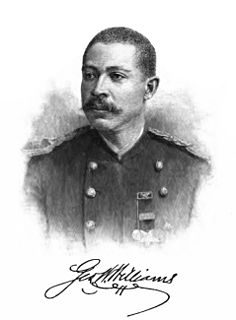
Martin Luther King Sr. was an African American Baptist pastor, missionary, and an early figure in the Civil Rights Movement. He was the father of civil rights leader Martin Luther King Jr.
Wyatt Tee Walker was an African-American pastor, national civil rights leader, theologian, and cultural historian. He was a chief of staff for Martin Luther King, Jr., and in 1958 became an early board member of the Southern Christian Leadership Conference (SCLC). He helped found a Congress for Racial Equality (CORE) chapter in 1958. As executive director of the SCLC from 1960 to 1964, Walker helped to bring the group to national prominence.

The Black Heritage Trail is a path in Boston, Massachusetts, winding through the Beacon Hill neighborhood and sites important in African-American history. The Black Heritage Trail links more than 15 pre-Civil War structures and historic sites, including the 1806 African Meeting House, the oldest surviving black church in the United States.

The Boston African American National Historic Site, in the heart of Boston, Massachusetts's Beacon Hill neighborhood, interprets 15 pre-Civil War structures relating to the history of Boston's 19th-century African-American community. These include the 1806 African Meeting House, the oldest standing black church in the United States.

Anthony Burns was a fugitive slave whose recapturing, extradition, and court case led to wide-scale public outcries of injustice, and ultimately, increased opposition to slavery by Northerners.
Claude William Black, Jr. was an American Baptist minister and political figure. He was born the son of local Brotherhood of Sleeping Car Porters vice president Claude, Sr. and housewife Cora in the then-segregated city of San Antonio, Texas.
Gardner Calvin Taylor was an American Baptist preacher. He was admired for his eloquence as well as his understanding of Christian faith and theology. He became known as "the dean of American preaching".
Joseph Harrison Jackson was an American pastor and the longest serving President of the National Baptist Convention, USA, Inc.

The Boston Vigilance Committee (1841-1861) was an abolitionist organization formed in Boston, Massachusetts, to protect escaped slaves from being kidnapped and returned to slavery in the South. The Committee aided hundreds of escapees, most of whom arrived as stowaways on coastal trading vessels and stayed a short time before moving on to Canada or England. Notably, members of the Committee provided legal and other aid to George Latimer, Ellen and William Craft, Shadrach Minkins, Thomas Sims, and Anthony Burns.

Charles Street African Methodist Episcopal Church is an historic African Methodist Episcopal Church at 551 Warren Street in Boston, Massachusetts. The current church building was built in 1888 by J. Williams Beal and added to the National Register of Historic Places in 1983.

Gillfield Baptist Church is the second-oldest black Baptist congregation in Petersburg, Virginia and one of the oldest in the nation. It has the oldest handwritten record book of any black church. It was organized in 1797 as a separate, integrated congregation. In 1818 it built its first church at its current lot on Perry Street.
Otis Moss Jr. is an American pastor, theologian, speaker, author, and activist. Moss is well known for his involvement in the Civil Rights Movement and his friendship with both Martin Luther King Jr. and Martin Luther King Sr. He is also the father of Otis Moss III, the current pastor of the famous Trinity United Church of Christ in Chicago.
Samuel Snowden was a 19th-century African-American abolitionist and pastor of the May Street Church, one of the first black Methodist churches in Boston, Massachusetts. Under Reverend Snowden's direction from 1818 to 1850, the May Street Church congregation supported the Underground Railroad; members included several prominent abolitionists, such as David Walker from North Carolina. Snowden was born into slavery in the South, but later reached the North and began his career as a pastor.
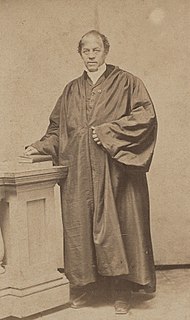
Leonard Andrew Grimes was an African-American abolitionist and pastor. He served as a conductor of the Underground Railroad, including his efforts to free fugitive slave Anthony Burns captured in accordance with the Fugitive Slave Act of 1850. After the Civil War began, Grimes petitioned for African-American enlistment. He then recruited soldiers for the 54th Regiment Massachusetts Volunteer Infantry.
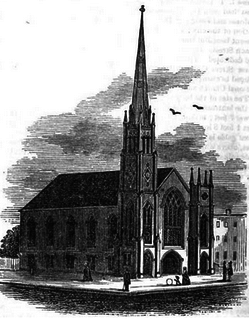
The Rowe Street Baptist Church was built in 1846 in Boston, Massachusetts. It was the third Baptist church built in the city.

Michael E. Haynes is an American minister and former politician in the state of Massachusetts. He was educated at Shelton State Community College and earned his bachelor's degree from New England School of Theology in 1949. He served in the Massachusetts House of Representatives from 1965 to 1968, representing Roxbury, Massachusetts. He has also been a member of the Boston Mayor's Committee on Violence and the Attorney General's Advisory Committee on Drug Addiction. He was pastor at Twelfth Baptist Church in Roxbury from 1964 to 2004.

Temple Baptist Church/King Solomon Baptist Church consists of two buildings at the intersection of Fourteenth Avenue and Marquette Avenue in Detroit, Michigan. The original church, which later became known as the Educational and Recreation Building, is a Tudor Revival structure built by architect J. Will Wilson in 1917, then remodeled and made into classrooms and office space by 1940. The second building, also known as the Main Auditorium, is an Art Deco building constructed in 1937 and remains largely unchanged. The buildings are now owned by King Solomon Missionary Baptist Church.
The Boston Women's Heritage Trail is a series of walking tours in Boston, Massachusetts, leading past sites important to Boston women's history. The tours wind through several neighborhoods, including the Back Bay and Beacon Hill, commemorating women such as Abigail Adams, Amelia Earhart, and Phillis Wheatley. The guidebook includes seven walks and introduces more than 200 Boston women.
Until 1950, African Americans were a small but historically important minority in Boston, where the population was overwhelmingly white. Since then, Boston's demographics have changed due to factors such as immigration, white flight, and gentrification. According to census information for 2010-2014, an estimated 180,657 people in Boston are Black/African American, either alone or in combination with another race. Despite being in the minority, and despite having faced housing, educational, and other discrimination, African Americans in Boston have made significant contributions in the arts, politics, and business since colonial times.

Calvary Baptist Church is a Baptist Church founded in 1879 in Chester, Delaware County, Pennsylvania, United States. Martin Luther King Jr. attended Calvary Baptist church while he studied at the Crozer Theological Seminary from 1948 to 1951.


